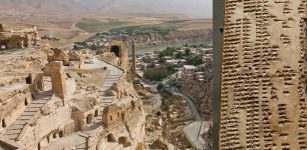Palermo Stone: Oldest History Book Of Ancient Egypt
MessageToEagle.com – Palermo Stone represents one of the basic sources of information about the chronology and cultural history of ancient Egypt during the first five dynasties (c. 2925–c. 2325 BC).
Named for the Sicilian city, where it has been preserved since 1877, it is one of six existing fragments from a single stela that probably originally stood in an Egyptian temple or other important building.
The Palermo Stone is an irregular shield-shaped fragment, 43.5 cm high, 25 cm wide and 6.5 cm thick (maximum dimensions).
The original to which the Palermo Stone belonged, is believed to have been about 2.2 meters long, 0.61 meters high and 6.5 cm thick.
It is generally accepted, but not proven, that the large Cairo Fragment, may have belonged to the same original.
It is inscribed on both sides with horizontal lines of hieroglyphic text, the top row listing the names of predynastic rulers.
The following rows, each headed by the name of a different king, are divided into compartments, each compartment signifying one year.
Palermo Stone consists of 6 horizontal bands or registers of hieroglyphic text running right to left. Within the compartments the hieroglyphs always list one or more memorable events of that year.
Thus, the original monument was apparently a year-by-year record of all the kings from the 1st through the 5th dynasty (c. 2925–c. 2325 BC), although the last name preserved on the stone is that of Neferirkare, the third of the nine kings of the 5th dynasty.

According to Palermo Stone, in the early 4th Dynasty, Sneferu sent a military expedition to Nubia. This expedition returned with 7,000 captives and 200,000 cattles. There is no further explanation in text, who the captives were and from which locations in Nubia.
See also: Why Ancient Egyptians Used Pillows Made Of Stone
The original location of the stele is unknown and none of the surviving fragments have a secure archaeological provenance. One fragment now in Cairo is said to have been found at an archaeological site at Memphis, while three other fragments now in Cairo were probably discovered in Middle Egypt.
No find site for the Palermo Stone itself has been suggested, also the purpose of this ancient artifact is not clearly defined. Was it meant to record historical events or had it another function?
Copyright © MessageToEagle.com All rights reserved. This material may not be published, broadcast, rewritten or redistributed in whole or part without the express written permission of MessageToEagle.com











